Febuxostat–p-Toluenesulfonic Acid Multi-Component Crystal: Characterization, Crystal Growth and Elucidation of the Salt/Co-Crystal Nature
Abstract
1. Introduction
2. Materials and Methods
2.1. Materials
2.2. Preparation Methods of the Tos1 Form
- -
- Crystallization methods
- Solvent-drop grinding
- Cooling evaporation in 2-ethoxyethanol and THF
- -
- MSZW determination
- -
- Scale-up and crystal growth
- Gram-scale by cooling-evaporation in THF
- Crystal growth
2.3. Methods for Evaluation
2.3.1. X-ray Powder Diffraction (XRPD) Studies
2.3.2. Differential Scanning Calorimetry Study
2.3.3. Thermogravimetric Analysis
2.3.4. Fourier Transform Infrared Spectroscopy
2.3.5. Powder Dissolution Measurement
- Determination of calibration curves
2.3.6. Stability Test
2.3.7. Single Crystal X-ray Diffraction (SC-XRD)
3. Results and Discussion
3.1. X-ray Powder Diffraction Analysis
3.2. Thermal Analysis
3.3. Fourier Transform Infrared Spectroscopy
3.4. Powder Dissolution Study
3.5. Crystal Growth and Crystal Structure Determination
3.5.1. Crystal Growth
3.5.2. Crystal Structure of Tos1
4. Conclusions
Supplementary Materials
Author Contributions
Funding
Data Availability Statement
Acknowledgments
Conflicts of Interest
References
- Khosravan, R.; Grabowski, B.; Wu, J.T. Effect of food or antacid on pharmacokinetics and pharmacodynamics of febuxostat in healthy subjects. Br. J. Clin. Pharmacol. 2008, 65, 355–363. [Google Scholar] [CrossRef] [PubMed]
- Smith, E.U.R.; Diaz-Torne, C.; Perez-Ruiz, F.; March, L.M. Epidemiology of gout: An update. Best Pract. Res. Clin. Rheumatol. 2010, 24, 811–827. [Google Scholar] [CrossRef] [PubMed]
- Pisaniello, H.L.; Lester, S.; Gonzalez-Chica, D. Gout prevalence and predictors of urate-lowering therapy use: Results from a population-based study. Arthritis Res. Ther. 2018, 20, 143. [Google Scholar] [CrossRef] [PubMed]
- Dehlin, M.; Jacobsson, L.; Roddy, E. Global epidemiology of gout: Prevalence, incidence, treatment patterns and risk factors. Nat. Rev. Rheumatol. 2020, 16, 380–390. [Google Scholar] [CrossRef]
- Roubenoff, R. Gout and hyperuricemia. Rheum. Dis. Clin. North Am. 1990, 16, 539–550. [Google Scholar] [CrossRef] [PubMed]
- Palella, T.D.; Fox, I.H.; Scriver, C.R.; Beaudet, A.L.; Sly, W.S.; Valle, D. Hyperuricemia and gout. In The Metabolic Basis of Inherited Disease, 6th ed.; McGraw-Hill: New York, NY, USA, 2003. [Google Scholar]
- Alirezaei, A.; Argani, H.; Asgharpour, M.; Bahadorimonfared, A.; Bakhtiyari, M. An update on allopurinol and kidney failure; new trend for an old drug. J. Renal Inj. Prev. 2017, 6, 297–302. [Google Scholar] [CrossRef]
- Drugs@FDA, 021856s000_Cross. R. Available online: http://www.accessdata.fda.gov/drugsatfda_docs/nda/2009/021856s000_CrossR.pdf (accessed on 17 April 2023).
- Pascual, E.; Sivera, F.; Yasothan, U.; Kirkpatrick, P. Febuxostat. Nat. Rev. Drug Discov. 2009, 8, 191–193. [Google Scholar] [CrossRef]
- Uloric, Takeda Pharmaceuticals America, Inc. Available online: https://www.uloric.com/ (accessed on 17 April 2023).
- Burns, C.M.; Wortmann, R.L. Gout therapeutics: New drugs for an old disease. Lancet 2011, 377, 165–177. [Google Scholar] [CrossRef]
- DrugBank. Available online: https://go.drugbank.com/drugs/DB04854 (accessed on 19 April 2023).
- Tang, J.; Bao, J.; Shim, X.; Sheng, X.; Su, W. Preparation, optimisation, and in vitro–in vivo evaluation of febuxostat ternary solid dispersion. J. Microencapsul. 2018, 35, 454–466. [Google Scholar] [CrossRef]
- Newman, A.; Wenslow, R. Solid form changes during drug development: Good, bad, and ugly case studies. AAPS Open 2016, 2, 2. [Google Scholar] [CrossRef]
- Hilfiker, R.; Blatter, F.; von Raumer, M. Relevance of solid-state properties for pharmaceutical products. Polymorph. Pharm. Ind. 2006, 1, 1–19. [Google Scholar]
- Nomura, J.; Kobayashi, T.; So, A.; Busso, N. Febuxostat, a Xanthine Oxidoreductase Inhibitor, Decreases NLRP3-dependent Inflammation in Macrophages by Activating the Purine Salvage Pathway and Restoring Cellular Bioenergetics. Sci. Rep. 2019, 9, 17314. [Google Scholar] [CrossRef] [PubMed]
- Maddileti, D.; Jayabun, S.K.; Nangia, A. Soluble cocrystals of the xanthine oxidase inhibitor febuxostat. Cryst. Growth Des. 2013, 13, 3188–3196. [Google Scholar] [CrossRef]
- An, J.H.; Lim, C.; Ryu, H.C.; Kim, J.S.; Kim, H.M.; Kiyonga, A.N.; Jung, K. Structural characterization of febuxostat/l-pyroglutamic acid cocrystal using solid-state 13C-NMR and investigational study of its water solubility. Crystals 2017, 7, 365. [Google Scholar] [CrossRef]
- Kang, Y.; Gu, J.; Hu, X. Syntheses, structure characterization and dissolution of two novel cocrystals of febuxostat. J. Mol. Struct. 2017, 1130, 480–486. [Google Scholar] [CrossRef]
- Gao, L.; Zhang, X. Cocrystallization of Febuxostat with Pyridine Coformers: Crystal Structural and Physicochemical Properties Analysis. J. Chem. 2021, 2021, 3834368. [Google Scholar] [CrossRef]
- Han, X.; Qi, W.; Dong, W.; Guo, M.; Ma, P.; Wang, J. Preparation, optimization and in vitro–in vivo investigation for capsules of the choline salt of febuxostat. Asian J. Pharm. Sci. 2016, 11, 715–721. [Google Scholar] [CrossRef]
- Zhang, X.R.; Zhang, L. Simultaneous enhancements of solubility and dissolution rate of poorly water-soluble febuxostat via salts. J. Mol. Struct. 2017, 1137, 328–334. [Google Scholar] [CrossRef]
- Li, L.Y.; Du, R.K.; Du, Y.L.; Zhang, C.J.; Guan, S.; Dong, C.Z.; Zhang, L. Febuxostat-minoxidil salt solvates: Crystal structures, characterization, interconversion and solubility performance. Crystals 2018, 8, 85. [Google Scholar] [CrossRef]
- Gao, L.; Zhang, X.R.; Chen, Y.F.; Liao, Z.L.; Wang, Y.Q.; Zou, X.Y. A new febuxostat imidazolium salt hydrate: Synthesis, crystal structure, solubility, and dissolution study. J. Mol. Struct. 2019, 1176, 633–640. [Google Scholar] [CrossRef]
- Baghernejad, B. Application of p-toluenesulfonic Acid (PTSA) in Organic Synthesis. Curr. Org. Chem. 2011, 15, 3091–3097. [Google Scholar] [CrossRef]
- Childs, S.L.; Stahly, G.P.; Park, A. The salt−cocrystal continuum: The influence of crystal structure on ionization state. Mol. Pharm. 2007, 4, 323–338. [Google Scholar] [CrossRef]
- Pongo, L.; Balazs, V.; Jozsef, B.; Dancso, A.; Lukacs, G.; Tompe, P.; Szent-Kirallyi, Z. New Salts, Polymorphs and Solvates of a Pharmaceutical Active Ingredient. WO 2012/020272 A2, 16 February 2012. [Google Scholar]
- Kumar Bandaru, R.; Rout, S.R.; Kenguva, G.; Gorain, B.; Alhakamy, N.A.; Kesharwani, P.; Dandela, R. Recent advances in pharmaceutical cocrystals: From bench to market. Front. Pharmacol. 2021, 12, 2954. [Google Scholar] [CrossRef] [PubMed]
- Bruker APEX4, v2021.4-0; Bruker AXS: Billerica, MA, USA, 2021.
- Sheldrick, G.M. IUCr SHELXT–Integrated Space-Group and Crystal-Structure Determination. Acta Crystallogr. 2015, 71, 3–8. [Google Scholar]
- Sheldrick, G.M. Crystal Structure Refinement with SHELXL. Acta Crystallogr. C Struct. Chem. 2015, 71, 3–8. [Google Scholar] [CrossRef] [PubMed]
- Dolomanov, O.v.; Bourhis, L.J.; Gildea, R.J.; Howard, J.A.K.; Puschmann, H. OLEX2: A Complete Structure Solution, Refinement and Analysis Program. J. Appl. Crystallogr. 2009, 42, 339. [Google Scholar] [CrossRef]
- Sigma-Aldrich. Available online: https://www.sigmaaldrich.com/RO/en/product/sial/402885 (accessed on 21 April 2023).
- Martin, F.A.; Pop, M.M.; Borodi, G.; Filip, X.; Kacso, I. Ketoconazole salt and co-crystals with enhanced aqueous solubility. Cryst. Growth Des. 2013, 13, 4295–4304. [Google Scholar] [CrossRef]


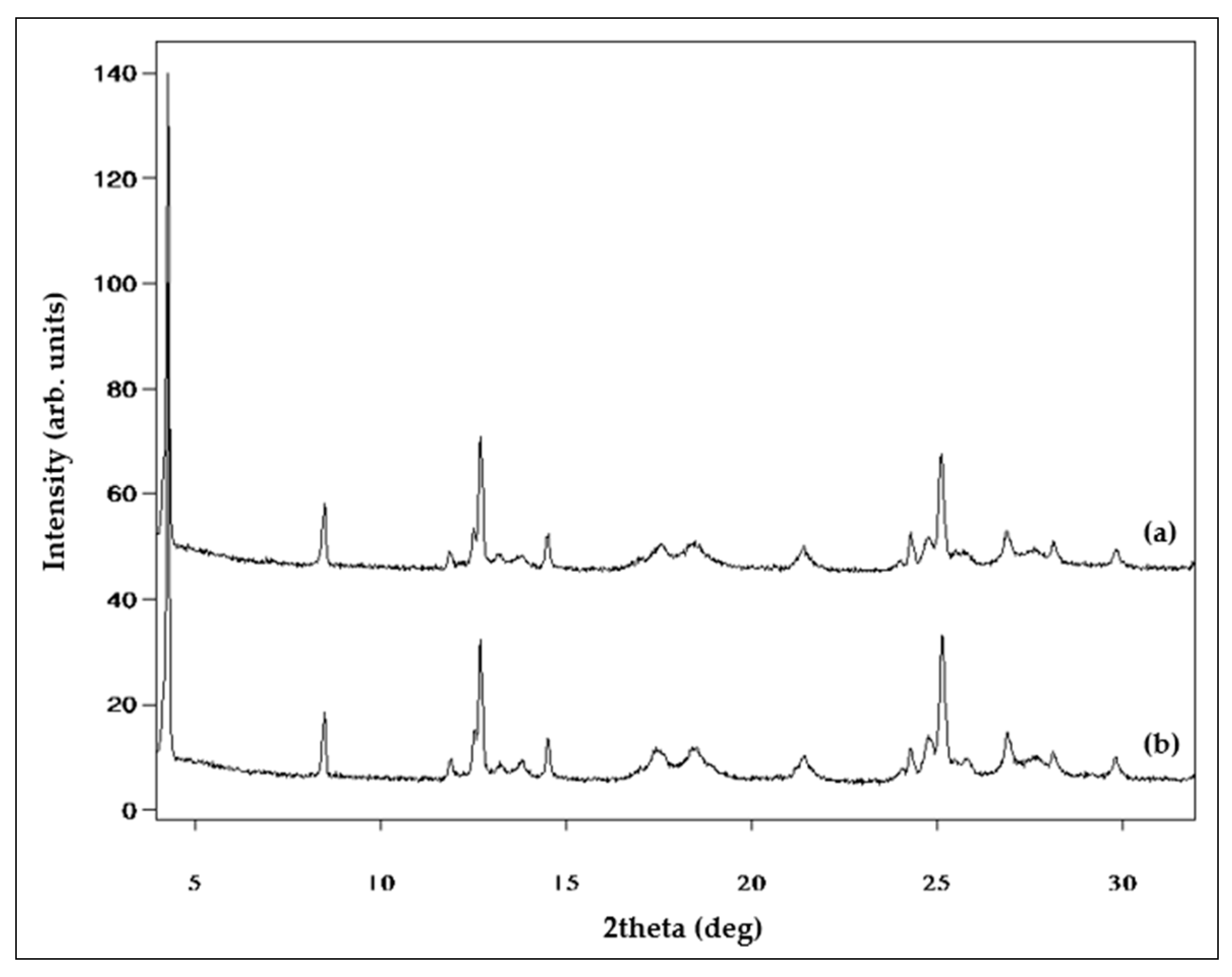
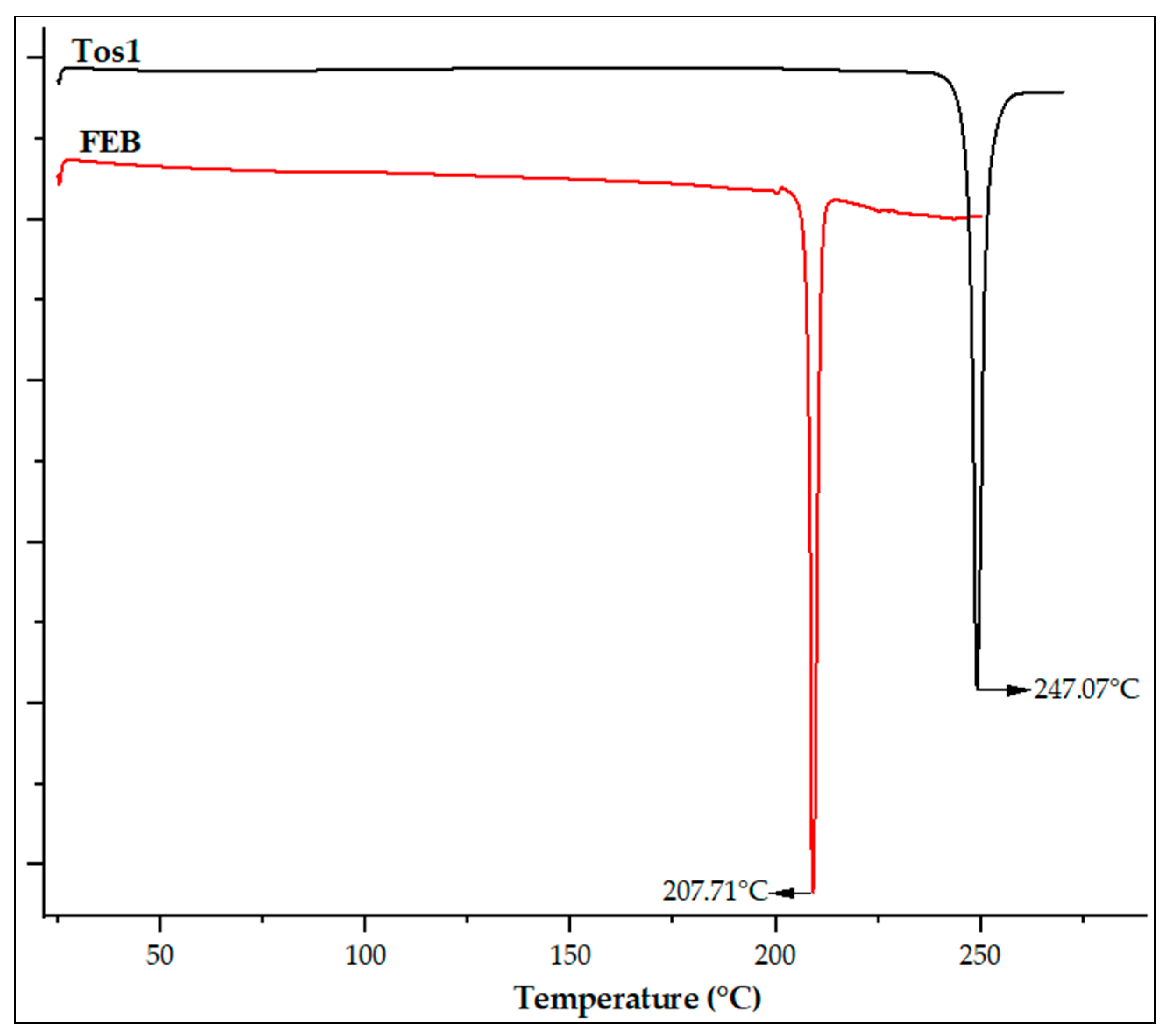

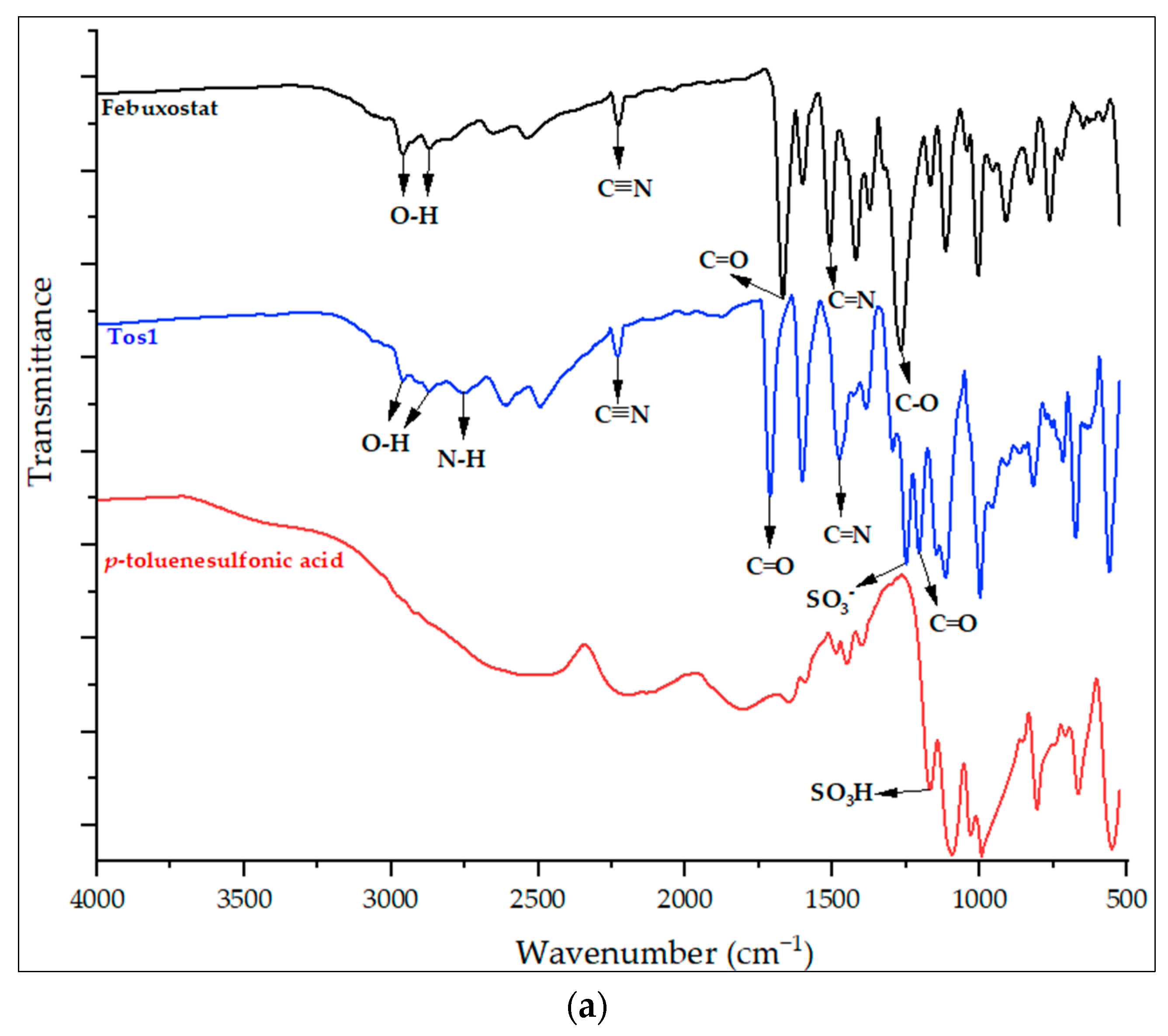
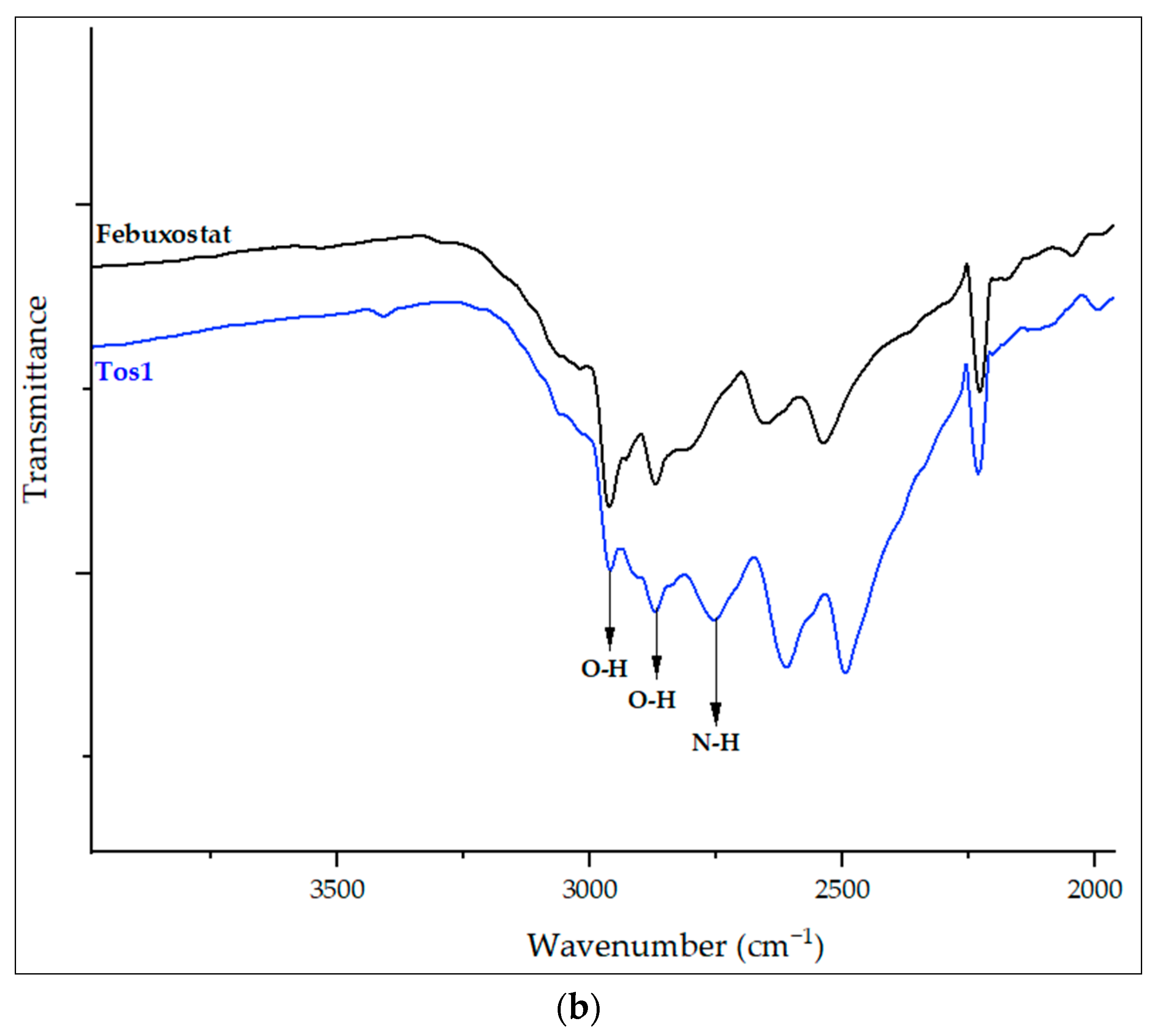
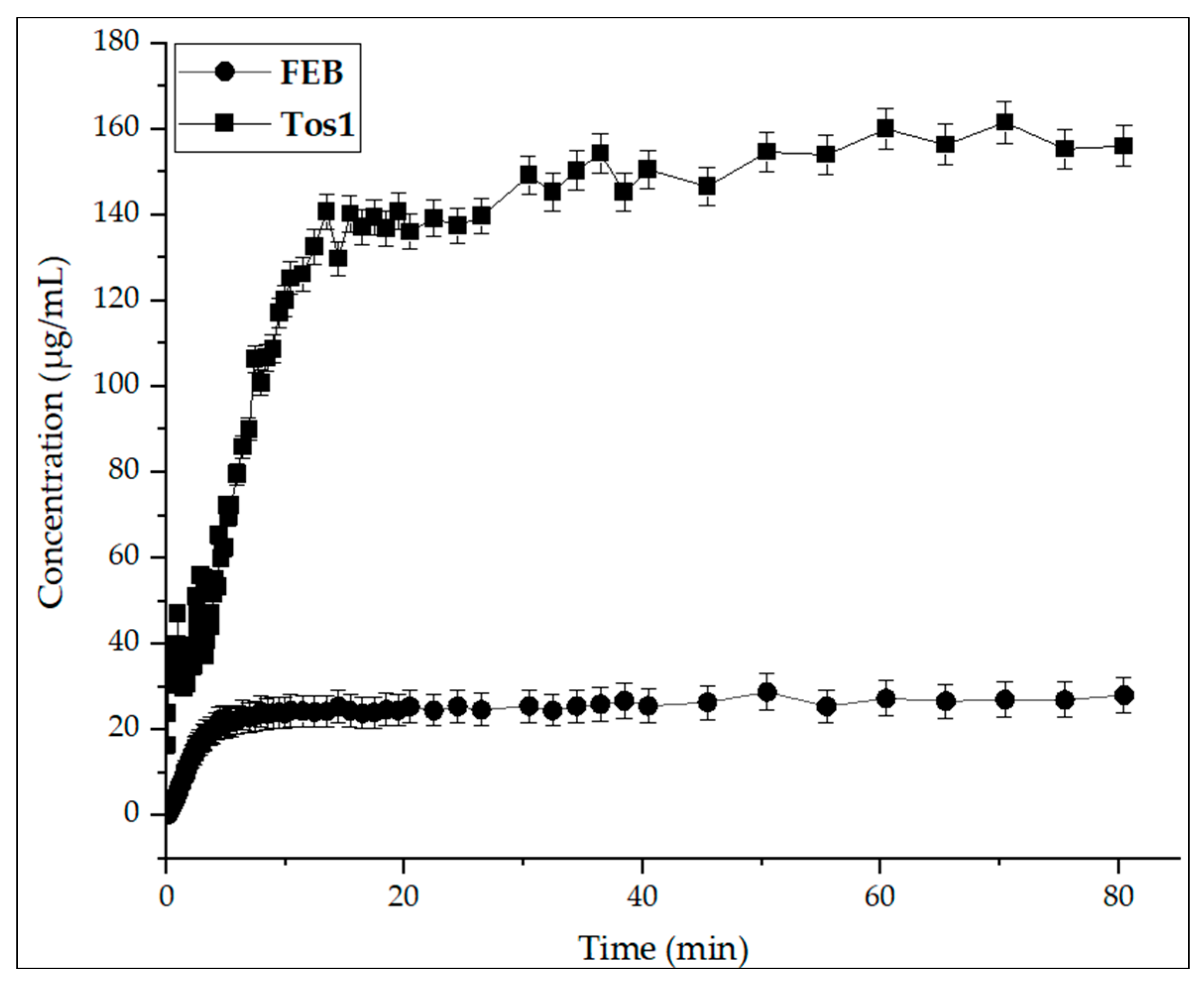

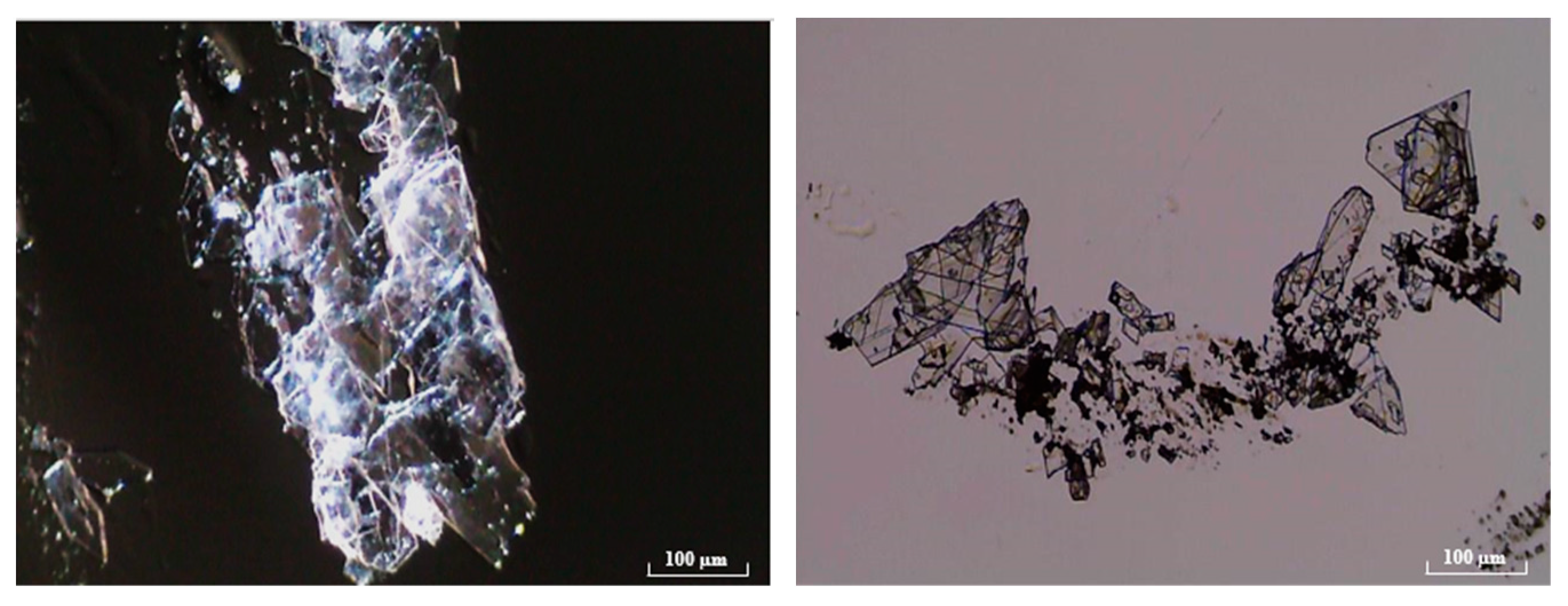




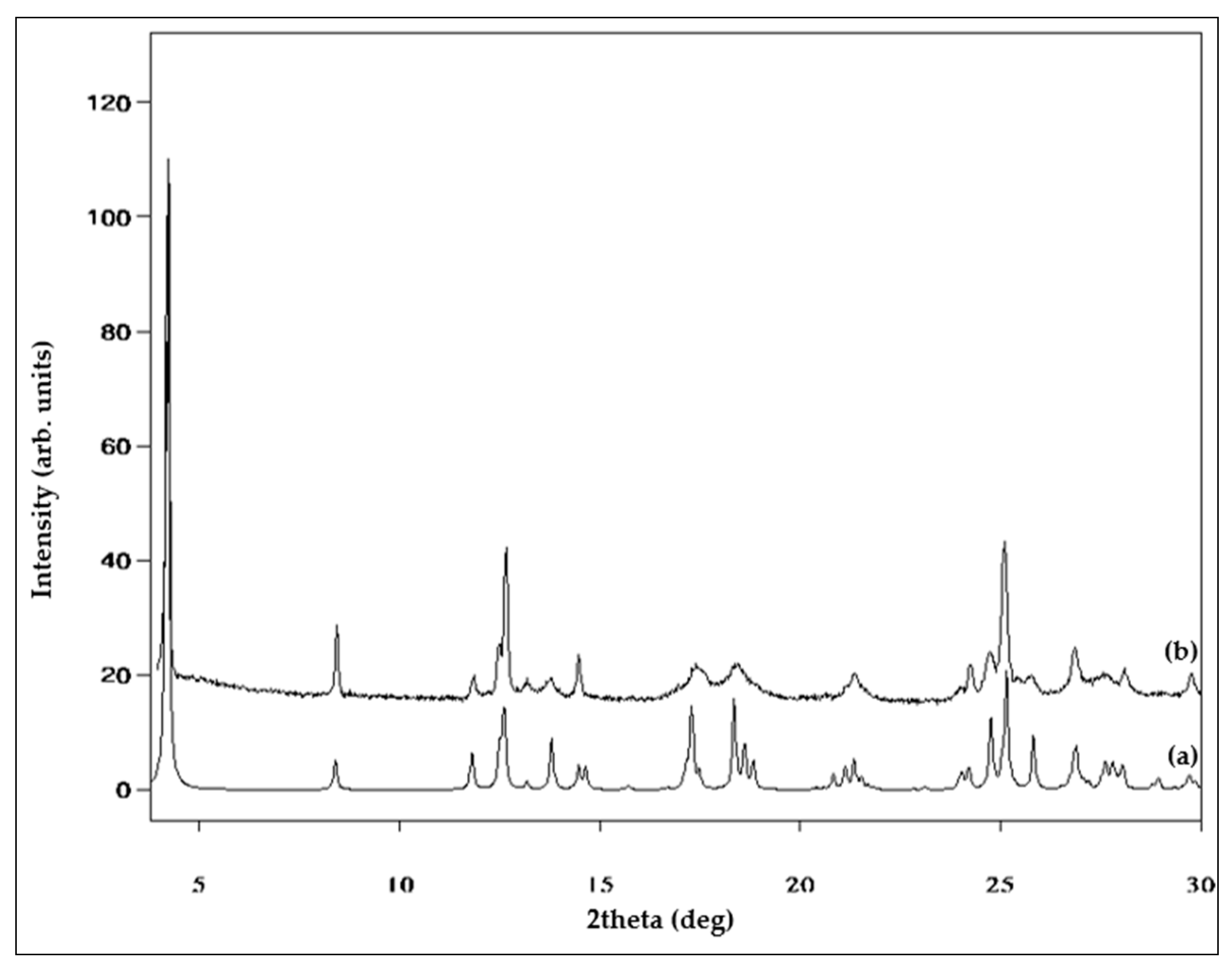
| D-H•••A | D-H | H-A | D-A | D-H-A |
|---|---|---|---|---|
| N1-H1•••O4 #1 | 1.11(8) | 1.60(8) | 2.672(8) | 160(6) |
| O3-H3•••O5 | 1.02(12) | 1.61(12) | 2.586(8) | 160(6) |
Disclaimer/Publisher’s Note: The statements, opinions and data contained in all publications are solely those of the individual author(s) and contributor(s) and not of MDPI and/or the editor(s). MDPI and/or the editor(s) disclaim responsibility for any injury to people or property resulting from any ideas, methods, instructions or products referred to in the content. |
© 2023 by the authors. Licensee MDPI, Basel, Switzerland. This article is an open access article distributed under the terms and conditions of the Creative Commons Attribution (CC BY) license (https://creativecommons.org/licenses/by/4.0/).
Share and Cite
Ungur, D.T.; Santiso-Quinones, G.; Pop, M.M.; Tamas, T.L.; Guguta, C.; Stam, D.; Mija, A.; Iordache, C.A. Febuxostat–p-Toluenesulfonic Acid Multi-Component Crystal: Characterization, Crystal Growth and Elucidation of the Salt/Co-Crystal Nature. Crystals 2023, 13, 836. https://doi.org/10.3390/cryst13050836
Ungur DT, Santiso-Quinones G, Pop MM, Tamas TL, Guguta C, Stam D, Mija A, Iordache CA. Febuxostat–p-Toluenesulfonic Acid Multi-Component Crystal: Characterization, Crystal Growth and Elucidation of the Salt/Co-Crystal Nature. Crystals. 2023; 13(5):836. https://doi.org/10.3390/cryst13050836
Chicago/Turabian StyleUngur, Doriana T., Gustavo Santiso-Quinones, Mihaela M. Pop, Tudor L. Tamas, Carmen Guguta, Danny Stam, Alice Mija, and Coca A. Iordache. 2023. "Febuxostat–p-Toluenesulfonic Acid Multi-Component Crystal: Characterization, Crystal Growth and Elucidation of the Salt/Co-Crystal Nature" Crystals 13, no. 5: 836. https://doi.org/10.3390/cryst13050836
APA StyleUngur, D. T., Santiso-Quinones, G., Pop, M. M., Tamas, T. L., Guguta, C., Stam, D., Mija, A., & Iordache, C. A. (2023). Febuxostat–p-Toluenesulfonic Acid Multi-Component Crystal: Characterization, Crystal Growth and Elucidation of the Salt/Co-Crystal Nature. Crystals, 13(5), 836. https://doi.org/10.3390/cryst13050836









